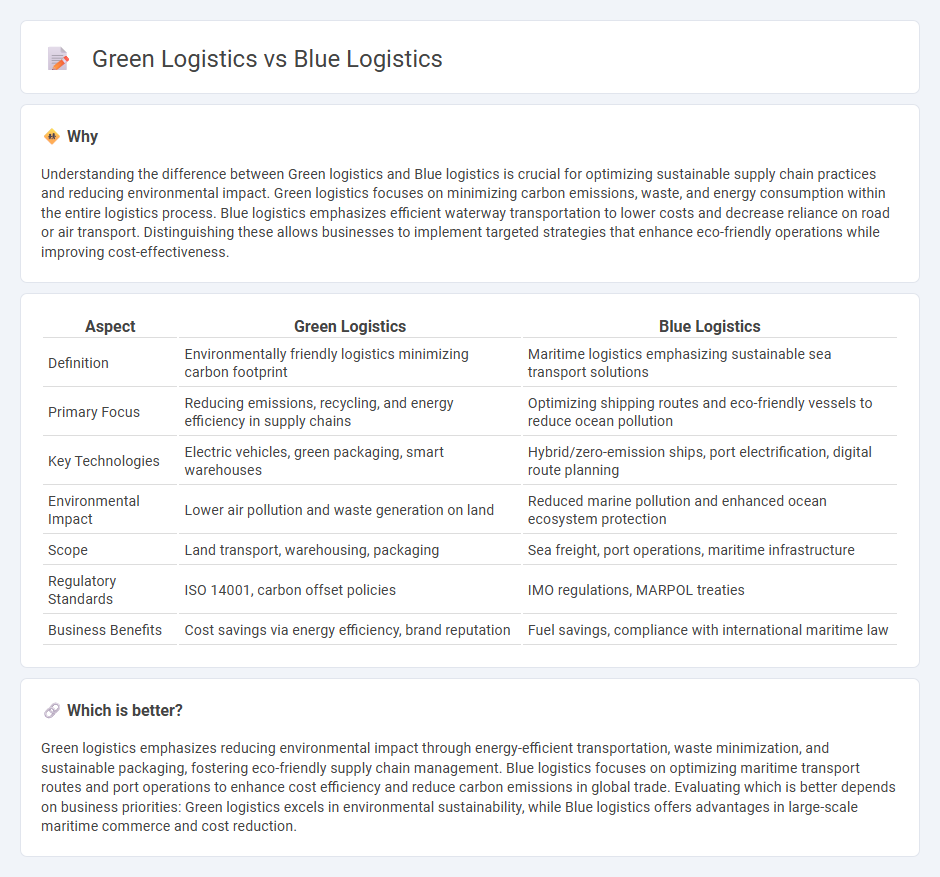
Green logistics focuses on minimizing environmental impact through sustainable practices such as reducing carbon emissions, optimizing supply chain efficiency, and utilizing eco-friendly transportation methods. Blue logistics emphasizes the role of maritime and water-based transportation in global trade, leveraging shipping routes and ports to enhance cost-effectiveness and reduce congestion on land. Explore the key differences and benefits of green and blue logistics to enhance sustainable commerce strategies.
Why it is important
Understanding the difference between Green logistics and Blue logistics is crucial for optimizing sustainable supply chain practices and reducing environmental impact. Green logistics focuses on minimizing carbon emissions, waste, and energy consumption within the entire logistics process. Blue logistics emphasizes efficient waterway transportation to lower costs and decrease reliance on road or air transport. Distinguishing these allows businesses to implement targeted strategies that enhance eco-friendly operations while improving cost-effectiveness.
Comparison Table
| Aspect | Green Logistics | Blue Logistics |
|---|---|---|
| Definition | Environmentally friendly logistics minimizing carbon footprint | Maritime logistics emphasizing sustainable sea transport solutions |
| Primary Focus | Reducing emissions, recycling, and energy efficiency in supply chains | Optimizing shipping routes and eco-friendly vessels to reduce ocean pollution |
| Key Technologies | Electric vehicles, green packaging, smart warehouses | Hybrid/zero-emission ships, port electrification, digital route planning |
| Environmental Impact | Lower air pollution and waste generation on land | Reduced marine pollution and enhanced ocean ecosystem protection |
| Scope | Land transport, warehousing, packaging | Sea freight, port operations, maritime infrastructure |
| Regulatory Standards | ISO 14001, carbon offset policies | IMO regulations, MARPOL treaties |
| Business Benefits | Cost savings via energy efficiency, brand reputation | Fuel savings, compliance with international maritime law |
Which is better?
Green logistics emphasizes reducing environmental impact through energy-efficient transportation, waste minimization, and sustainable packaging, fostering eco-friendly supply chain management. Blue logistics focuses on optimizing maritime transport routes and port operations to enhance cost efficiency and reduce carbon emissions in global trade. Evaluating which is better depends on business priorities: Green logistics excels in environmental sustainability, while Blue logistics offers advantages in large-scale maritime commerce and cost reduction.
Connection
Green logistics focuses on reducing environmental impact through eco-friendly transportation and sustainable supply chain practices, while blue logistics emphasizes the use of water-based routes and maritime transport to optimize efficiency. Both approaches prioritize minimizing carbon emissions and resource consumption by innovating in transportation modes and infrastructure. Integrating green logistics principles with blue logistics strategies enhances sustainable commerce by leveraging marine pathways to support cleaner, cost-effective distribution networks.
Key Terms
Sustainability
Blue logistics emphasizes energy-efficient maritime transport and reduced carbon emissions through optimized shipping routes and cleaner fuels. Green logistics broadens the scope by integrating environmentally friendly practices across the entire supply chain, including sustainable packaging, eco-friendly warehousing, and minimizing waste. Explore detailed strategies and case studies to understand how both approaches drive sustainability in modern logistics.
Carbon Emissions
Blue logistics emphasizes efficient maritime transport routes to reduce fuel consumption and minimize carbon emissions in global supply chains. Green logistics prioritizes eco-friendly practices across all transportation modes, including electric vehicles and sustainable warehousing, to lower overall environmental impact. Explore how integrating both strategies can optimize carbon reduction in logistics management.
Supply Chain Optimization
Blue logistics emphasizes leveraging advanced maritime and digital transport technologies to enhance supply chain efficiency through optimized routing and real-time tracking, reducing operational costs and delivery times. Green logistics prioritizes sustainability by minimizing carbon emissions, utilizing eco-friendly packaging, and implementing energy-efficient transportation methods to achieve circular supply chains and regulatory compliance. Explore deeper insights into how integrating blue and green logistics strategies can revolutionize your supply chain optimization.
Source and External Links
Blue Logistics Group - Redefining Logistics - Blue Logistics Group offers comprehensive transport and logistics services including air, sea, and road freight with a focus on sustainability and tailor-made solutions to meet diverse shipping needs.
Blue Logistics Services - Blue Logistics Services provides supply chain and shipment solutions with state-of-the-art resources, covering air cargo, sea cargo, land transit, warehousing, and packing services.
Blue Logistics - A full-service brokerage specializing in truckload, expedited, and LTL shipments with a focus on integrity, offering a variety of equipment for transportation and over 40 years of experience.
 dowidth.com
dowidth.com